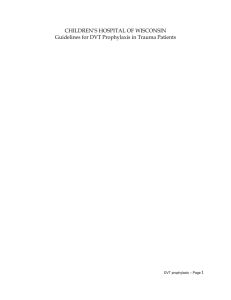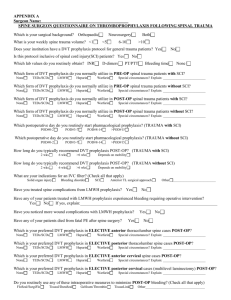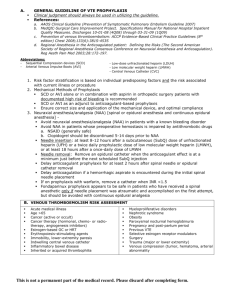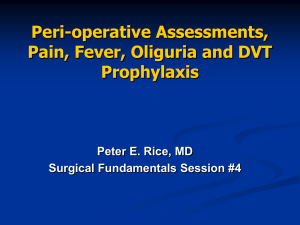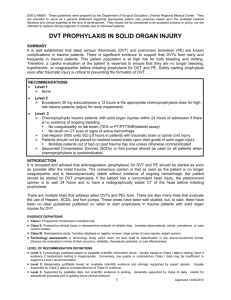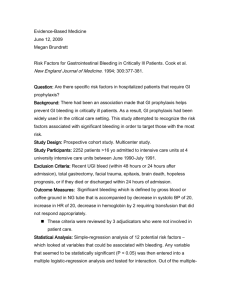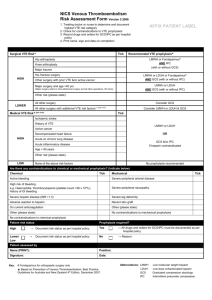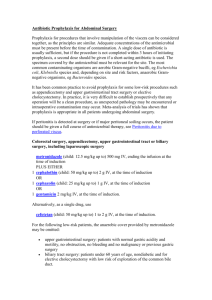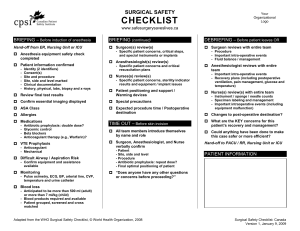Deep Venous Thrombosis
advertisement
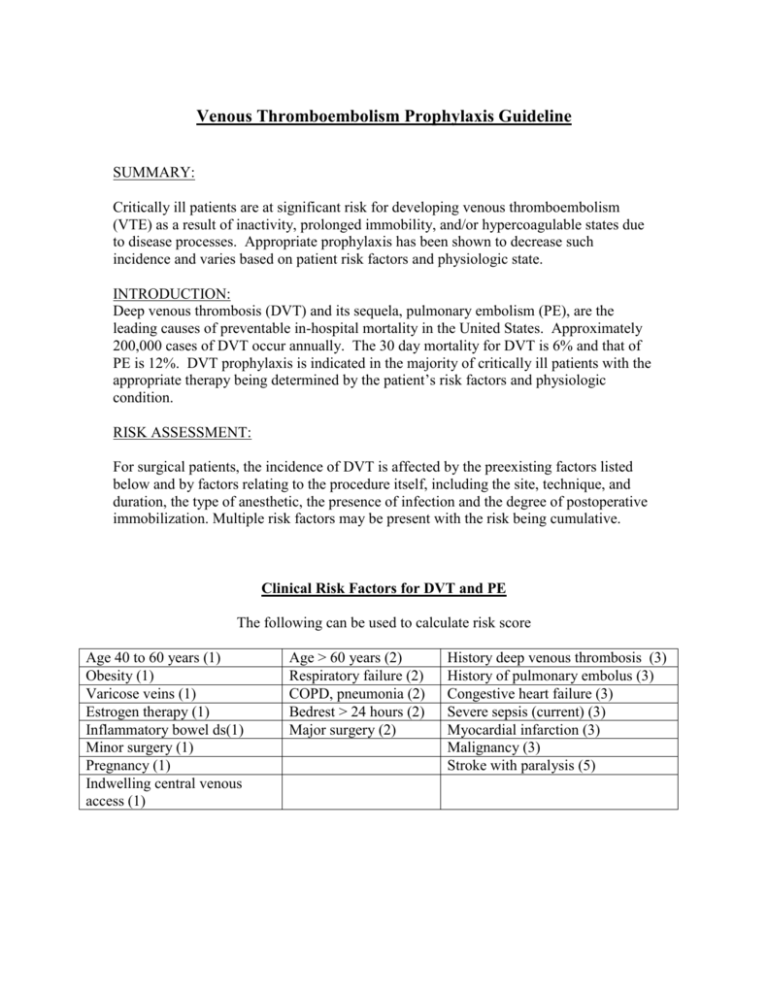
Venous Thromboembolism Prophylaxis Guideline SUMMARY: Critically ill patients are at significant risk for developing venous thromboembolism (VTE) as a result of inactivity, prolonged immobility, and/or hypercoagulable states due to disease processes. Appropriate prophylaxis has been shown to decrease such incidence and varies based on patient risk factors and physiologic state. INTRODUCTION: Deep venous thrombosis (DVT) and its sequela, pulmonary embolism (PE), are the leading causes of preventable in-hospital mortality in the United States. Approximately 200,000 cases of DVT occur annually. The 30 day mortality for DVT is 6% and that of PE is 12%. DVT prophylaxis is indicated in the majority of critically ill patients with the appropriate therapy being determined by the patient’s risk factors and physiologic condition. RISK ASSESSMENT: For surgical patients, the incidence of DVT is affected by the preexisting factors listed below and by factors relating to the procedure itself, including the site, technique, and duration, the type of anesthetic, the presence of infection and the degree of postoperative immobilization. Multiple risk factors may be present with the risk being cumulative. Clinical Risk Factors for DVT and PE The following can be used to calculate risk score Age 40 to 60 years (1) Obesity (1) Varicose veins (1) Estrogen therapy (1) Inflammatory bowel ds(1) Minor surgery (1) Pregnancy (1) Indwelling central venous access (1) Age > 60 years (2) Respiratory failure (2) COPD, pneumonia (2) Bedrest > 24 hours (2) Major surgery (2) History deep venous thrombosis (3) History of pulmonary embolus (3) Congestive heart failure (3) Severe sepsis (current) (3) Myocardial infarction (3) Malignancy (3) Stroke with paralysis (5) Non-Trauma Surgery Risk Assessment and Therapeutic Recommendations There is no place for aspirin alone as prophylaxis against VTE for any patient group. Low Risk: 0-1 No treatment needed: early ambulation Moderate Risk: 2 Prophylaxis needed: LDUH q 12 hours OR LMWH OR IPC High Risk: 3-4 Prophylaxis needed: LDUH q 8 hours OR LMWH OR IPC Highest Risk: 5 or greater Prophylaxis needed: LDUH q 8 hours + IPC OR LMWH + IPC The abdominal general surgery patient is considered major surgery, so the patient begins at moderate risk level and then goes to high or highest risk depending on age and risk factors. LDUH: low dose unfractionated heparin 5000 units subcutaneous q 8-12 hrs as noted LMWH: low molecular weight heparin 30 mg subcutaneous q12 hours IPC: intermittent pneumatic compression devices Trauma Surgery: Without prophylaxis, patients with multi-system or major trauma have a risk for DVT that exceeds 50% and a risk of fatal PE of approximately 0.4-2%. DVT is seen in greater than 50% of lower extremity fractures, spine fractures and major head injury and approximately 40% of patients with blunt thoracoabdominal injuries. Additional Risk Factors Specific to Trauma Patients Spinal cord injury, paralysis (5) Venous Injury (5) Pelvis/hip/lower extremity fracture (5) Major trauma (5) Trauma Surgery Risk Assessment and Therapeutic Recommendations We recommend that all trauma patients without contraindications and a Risk Score of > 2 receive LMWH 30 mg subcutaneously q 12 hours If patient < 45 kg, decrease dosage to 0.5 mg/kg subcutaneous q 12 hours If patient BMI > 35, increase dosage to 40 mg subcutaneous q 12 hours If renal failure and CrCl < 30 ml/min: 30 mg subcutaneous daily We recommend that mechanical methods of prophylaxis (IPC) be used primarily in patients who are at high risk of bleeding or as an adjunct to anticoagulant-based prophylaxis Careful attention must be directed toward ensuring the proper use of and optimal compliance with the mechanical device. Inferior vena cava filters (IVCF) insertion is not recommended for primary prophylaxis unless very high risk patients with contraindications to anticoagulation (see IVCF guideline) DISCUSSION: LDUH is not effective in the trauma patient and has been shown to be equivalent to no prophylaxis in high risk trauma patients and therefore has no indication in this patient population. LMWH should be considered the agent of choice for DVT prophylaxis in the trauma patient without ongoing hemorrhage or uncontrolled coagulopathy. For patients with contraindications to LMWH prophylaxis, IPC should be initiated with institution of LMWH prophylaxis once primary hemostasis is obtained. As the optimal duration of therapy is not known, therapy should continue until discharge from the hospital. Current absolute contraindications to early initiation of LMWH prophylaxis include the following: Intracranial hemorrhage Incomplete spinal cord injury with associated peri-spinal hematomas Ongoing uncontrolled hemorrhage Uncorrected coagulopathy Intraventricular monitor or epidural catheter History of heparin induced thrombocytopenia (HIT) Platelet count < 50,000 . Level III recommendations include placement of IVCF in high risk trauma patients who cannot receive anticoagulation because of increased bleeding risk. The problem is defining the high-risk patient. One trauma study identified four injury patterns that accounted for 92% of PEs: Spinal cord injury with paraplegia or quadriplegia Severe closed head injury with a Glasgow Coma Score 8 Age > 55 years with isolated long bone fractures Complex pelvic fractures associated with long bone fractures Another retrospective review including 9,721 patients showed that the high risk categories include Head injury plus spinal cord injury Head injury plus long bone fracture Severe pelvic fracture plus long bone fracture Multiple long bone fractures These authors estimate that if they would have utilized a prophylactic filter in these 2% of patients, there would have been a very dramatic reduction in PE. They suggested that patients with an estimated risk of PE of 2% to 5%, despite prophylaxis, are reasonable candidates for prophylactic vena caval filter placement, especially if conventional prophylactic measures cannot be used. Although it is generally accepted that IVCF reduce the risk of PE overall and fatal PE specifically, this has not been consistently proven, particularly when used for prophylactic indications. Reports exist of PE in the first 24-48 hours after injury and frequently being noted before 72 hours therefore this decision needs to be made early in the patients hospital stay to have the most effect. Consideration should be given to placing IVCF as soon as able (within 24 hours). The presence of brain injury without frank hemorrhage, complete spinal cord injuries, laceration or contusion of internal organs such as lung, liver, spleen or kidneys or the presence of retroperitoneal hematomas associated with pelvic fracture do not by themselves contraindicate the use of LMWH prophylaxis as long as there is no clinical indications of active bleeding. LMWH has been shown to be safely used for VTE prophylaxis in patients with traumatic brain injuries 24 hours after hospital admission or craniotomy. This stresses the need for daily reassessment to initiate pharmacologic prophylaxis Duration of therapy: As the optimal duration of therapy is not known, therapy should continue until discharge from the hospital. A study of patients after their discharge from the hospital following major surgery confirmed that the risks of developing thromboembolic disease can extend beyond the patient's stay in the hospital. Once patients return home, they may be even less mobile than they were in the hospital. Of 57 patients studied, 13 developed DVT during the 6 weeks after surgery, despite having shown no signs of this complaint while in the hospital. The use of LMWH or oral anticoagulants for several weeks post-injury should be considered in patients who remain at high risk for DVT (fractures, spinal cord injuries, prolonged bed rest, prolonged hospitalization or rehabilitation) SCREENING MEASURES: Low Risk: No routine Screening Moderate/High Risk: Venous Duplex weekly Highest Risk: Venous Duplex 2 times in 1st week (first within 72 hours of arrival) and weekly thereafter
